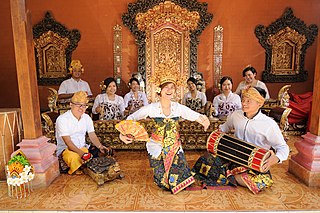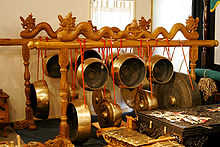
Gamelan is the traditional ensemble music of the Javanese, Sundanese, and Balinese peoples of Indonesia, made up predominantly of percussive instruments. The most common instruments used are metallophones played by mallets and a set of hand-played drums called kendhang which register the beat. The kemanak and gangsa are commonly used gamelan instruments. Other instruments include xylophones, bamboo flutes, a bowed instrument called a rebab, and even vocalists named sindhen.

The music of Indonesia demonstrates its cultural diversity, the local musical creativity, as well as subsequent foreign musical influences that shaped contemporary music scenes of Indonesia. Nearly thousands of Indonesian islands having its own cultural and artistic history and character. This results in hundreds of different forms of music, which often accompanies by dance and theatre.

Gamelan degung is a Sundanese musical ensemble that uses a subset of modified gamelan instruments with a particular mode of pelog scale. The instruments are manufactured under local conditions in towns in West Java such as Bogor. Degung music is often played at public gatherings in West Java, such as at local elections, as well as many other events. There is international interest in degung as well among communities in other countries interested in Indonesia and gamelan music.
Pelog is one of the two essential scales of gamelan music native to Bali and Java, in Indonesia. In Javanese the term is said to be a variant of the word pelag meaning "fine" or "beautiful". The other, older, scale commonly used is called slendro. Pelog has seven notes, but many gamelan ensembles only have keys for five of the pitches. Even in ensembles that have all seven notes, many pieces only use a subset of five notes.

Slendro is a pentatonic scale, Play (help·info) the older of the two most common scales (laras) used in Indonesian gamelan music, the other being pélog. In Javanese the term is said to derive either from "Sailendra", the name of the ruling family in the eighth and ninth centuries when Borobudur was built, or from its earlier being given by the god Sang Hyang Hendra.

Bali is an Indonesian island that shares in the gamelan and other Indonesian musical styles. Bali, however, has its own techniques and styles, including kecak, a form of singing that imitates the sound of monkeys. In addition, the island is home to several unique kinds of gamelan, including the gamelan jegog, gamelan gong gede, gamelan gambang, gamelan selunding and gamelan semar pegulingan, the cremation music angklung and the processional music bebonangan. Modern popular styles include gamelan gong kebyar, dance music which developed during the Dutch occupation and 1950's era joged bumbung, another popular dance style. In Balinese music you can also hear metallophones, gongs and xylophones.

Joged bumbung is a style of gamelan music from Bali, Indonesia on instruments made primarily out of bamboo. The ensemble gets its name from joged, a flirtatious dance often performed at festivals and parties. This style of Gamelan is especially popular in Northern and Western Bali, but is easily found all over the island. Unlike many styles of Balinese Gamelan which have sacred roles in religious festivals, Joged music is much more secular, and in many ways has become the folk music of Bali. With the rapid rise of tourism in recent decades, Joged music is now often found being performed at hotels and restaurants.

A kempul is a type of hanging gong used in Indonesian gamelan. The kempul is a set of pitched, hanging, knobbed gongs, often made of bronze, wood, and cords. Ranging from 19 cm to 25,4 cm in diameter, the kempul gong has a flat surface with a protruding knob at the center and is played by hitting the knob with the "soft end of a mallet." "The wooden mallet used has a ball shape head with heavy padding on a short wooden handle. The number of kempul gongs present in a gamelan ensemble varies but, "although there can be two to ten kempul on one separate rack, it is common to have five kempul hanging on the same rack as the Gong ageng and gong siyem".

Gamelan semar pegulingan is an old variety of the Balinese gamelan. Dating back from around the 17th century, the style is sweeter and more reserved than the more popular and progressive Gamelan Gong Kebyar. Semar pegulingan is derived from the ancient flute ensemble gamelan gambuh which utilizes a 7 tone scale. Semar pegulingan also uses the 7 tone scale which enables several pathet to be played. Semar is the name of the Hindu God of love and pegulingan means roughly 'laying down'. It was originally played near the sleeping chambers of the palace to lull the king and his concubines to sleep. The ensemble includes suling, various small percussion instruments similar to sleigh bells and finger cymbals, and trompong - a row of small kettle gongs that play the melody. A similar type of ensemble, Gamelan Pelegongan, substitutes a pair of gendérs for the trompong as the melody carrier and plays the music for a set of dances known as legong.

Gamelan selunding is a sacred ensemble of gamelan music from Bali, Indonesia. The selunding ensemble is from Tenganan, a village in east Bali; the ensemble is rare. Selunding means "great" or "large." Selonding is also a musical instrument made of iron.

The gong ageng is an Indonesian musical instrument used in the Javanese gamelan. It is the largest of the bronze gongs in the Javanese and Balinese gamelan orchestra and the only large gong that is called gong in Javanese. Unlike the more famous Chinese or Turkish tam-tams, Indonesian gongs have fixed, focused pitch, and are dissimilar to the familiar crash cymbal sound. It is circular, with a conical, tapering base of diameter smaller than gong face, with a protruding polished boss where it is struck by a padded mallet. Gongs with diameter as large as 135 centimeters have been created in the past, but gongs larger than about 80 centimeters are more common especially to suit the budget of educational institutions.

The Kenong is a musical instrument of Indonesia used in the gamelan. It is a kind of gong and It is placed on its side. It has the same length and width. Thus it is similar to the bonang, kempyang and ketuk, which are also cradled gongs. Kenongs are generally much larger than the aforementioned instruments. However. It has a considerably higher pitch. Its sound stands out because of its unique timbre. The kenong sticks are taller than that of the bonang. The kenong is sometimes played by the same player as the kempyang and ketuk.
The sèlèh note or nada seleh is an Indonesian music concept used in Javanese gamelan music. In Javanese gamelan music, the sèlèh note or nada seleh is the final note of a gatra, or four-beat melodic unit. As such it is the note which serves as the goal for all the various strands of the musical texture.
Notation plays a relatively minor role in the oral traditions of Indonesian gamelan but, in Java and Bali, several systems of gamelan notation were devised beginning at the end of the 19th century, initially for archival purposes.
Irama is the term used for tempo in Indonesian gamelan in Java and Bali. It can be used with elaborating instruments. It is a concept used in Javanese gamelan music, describing melodic tempo and relationships in density between the balungan, elaborating instruments, and gong structure. It is distinct from tempo, as each Irama can be played in different tempi. Irama thus combines "the rate of temporal flow and temporal density"; and the temporal density is the primary factor.

Kroncong is the name of a ukulele-like instrument and an Indonesian musical style that typically makes use of the kroncong. A kroncong orchestra or ensemble traditionally consists of a flute, a violin, at least one, but usually a pair of kroncongs, a cello in pizzicato style, string bass in pizzicato style, and a vocalist. Kroncong originated as an adaptation of a Portuguese musical tradition, brought by sailors to Indonesian port cities in the 16th century. By the late 19th century, kroncong reached popular music status throughout the Indonesian archipelago.

The Gamelan Sekaten is a ceremonial gamelan from central Java, Indonesia, played during the annual Sekaten festival. The word "sekaten" itself is derived from syahadatain or shahada, the first requirement for converting into Islamic faith. Traditionally it is played once per year, on the occasion of Mawlid, Muhammad's birthday, for the week from the 6-12 of the month of Mulud. On this celebration it is brought from the palace at 11 pm to two pavilions before the Great Mosque. It is played every day during that week except the Thursday night/Friday morning. On the eve of the birthday proper, it is returned at 11 pm.

The Malay gamelan which exists today in Riau province in Indonesia and Malaysia is basically from royal passed down through heritage. The Malay gamelan has developed an identity that is distinct from the Javanese, Balinese and Sundanese gamelans from Indonesia.

Gandrung is a traditional dance from Indonesia. Gandrung has many variations and is popular in Bali, Lombok and East Java among the Balinese, Sasak and Javanese. The most popular variation is gandrung from the Banyuwangi region in the eastern peninsula of Java, so much that the city is often referred as Kota Gandrung or "the city of gandrung".

The Rough Guide to the Music of Indonesia is a world music compilation album originally released in 2000. Part of the World Music Network Rough Guides series, the release covers a broad swathe of the music of Indonesia, both traditional and modern. The compilation was produced by Phil Stanton, co-founder of the World Music Network. Paul Fisher compiled the tracks and wrote the liner notes, and Duncan Baker coordinated the project.















